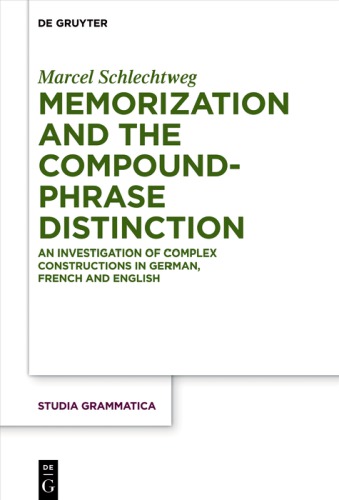

Most ebook files are in PDF format, so you can easily read them using various software such as Foxit Reader or directly on the Google Chrome browser.
Some ebook files are released by publishers in other formats such as .awz, .mobi, .epub, .fb2, etc. You may need to install specific software to read these formats on mobile/PC, such as Calibre.
Please read the tutorial at this link. https://ebooknice.com/page/post?id=faq
We offer FREE conversion to the popular formats you request; however, this may take some time. Therefore, right after payment, please email us, and we will try to provide the service as quickly as possible.
For some exceptional file formats or broken links (if any), please refrain from opening any disputes. Instead, email us first, and we will try to assist within a maximum of 6 hours.
EbookNice Team

Status:
Available5.0
5 reviews
ISBN 10: 3110568624
ISBN 13: 9783110568622
Author: Marcel Schlechtweg
Over the last decades, it has been hotly debated whether and how compounds, i.e. word-formations, and phrases differ from each other. The book discusses this issue by investigating compounds and phrases from a structural, semantic-functional and, crucially, cognitive perspective. The analysis focuses on compounds and phrases that are composed of either an adjective and a noun or two nouns in German, French and English. Having distinguished compounds from phrases on structural and semantic-functional grounds, the author claims that compounds are by their nature more appropriate to be stored in the mental lexicon than phrases and supports his argument with empirical evidence from new psycholinguistic studies. In sum, the book maintains the separation between compounds and phrases and reflects upon its cognitive consequences.
1 Filler items of the first experimental study
2 Relevant Tukey multiple comparisons of the interaction of language x item type x day (response time, first experimental study)
3 Numbers of observations (N), means (M) and standard deviations (SD) of the interactions of language x day and item type x day (Response time, first experimental study)
4 Non-significant Tukey multiple comparisons of language (response time, first experimental study)
5 Remaining Tukey multiple comparisons of the interaction of language x item type (response accuracy, first experimental study), comparisons of the experimental items across languages
6 Relevant Tukey multiple comparisons of the interaction of language x item type x day (response accuracy, first experimental study)
7 Numbers of observations (N), means (M) and standard deviations (SD) of the interactions of language x day and item type x day (Response accuracy, first experimental study)
8 Non-significant Tukey multiple comparisons of language (response accuracy, first experimental study)
9 Non-significant Tukey multiple comparisons of day (response accuracy, first experimental study)
10 Screenshots of the posttest (first experimental study) and pretest (second experimental study) (test created with Leiner 2014)
11 Filler items of the second experimental study
12 Remaining Tukey multiple comparisons of the interaction of stress x semantic compositionality (response time, second experimental study)
13 Relevant Tukey multiple comparisons of the interaction of stress x semantic compositionality x day (response time, second experimental study)
14 Remaining Tukey multiple comparisons of the interaction of stress x day (response time, second experimental study), comparisons of the experimental items with non-initial stress and the experimental items with initial stress
15 Remaining Tukey multiple comparisons of the interaction of semantic compositionality x day (response time, second experimental study), comparisons of the semantically non-compositional and the compositional experimental items
16 Remaining Tukey multiple comparisons of the interaction of stress x semantic compositionality (response accuracy, second experimental study)
17 Relevant Tukey multiple comparisons of the interaction of stress x semantic compositionality x day (response accuracy, second experimental study)
18 Tukey multiple comparisons of the interaction of stress x day (response accuracy, second experimental study)
19 Tukey multiple comparisons of the interaction of semantic compositionality x day (response accuracy, second experimental study)
20 Remaining Tukey multiple comparison of day (response accuracy, second experimental study)
the compound effect book quotes
the book compound effect
the compound book quotes and page numbers
all memorization techniques can be applied
memorization techniques pdf
Tags: Marcel Schlechtweg, Memorization, Compound